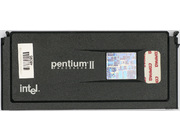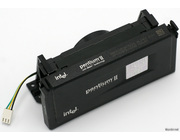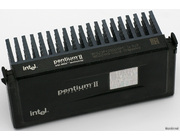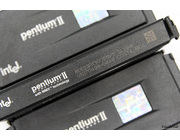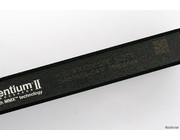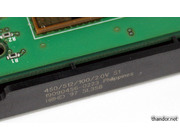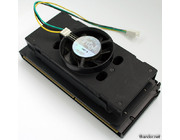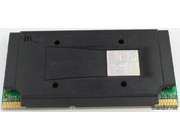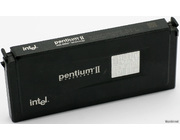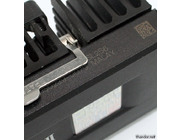Deschutes was launched in January 1998 at 333MHz as successor to Klamath. Later releases ran up to 450MHz using a 100MHz FSB. Due the higher FSB the processor needed a different chipset; the famous 440BX Seattle chipset.
At the end of the Pentium II-era Intel produced chips capable of 500MHz. These chips were never marketed and all the multiplier locked chips were being sold at 333MHz chips (5x66MHz instead of 5x100MHz).
Deschutes was a strong running processor; it performed well with both ALU and FPU instructions. AMD was struggling to compete with the Pentium II. Because the Pentium II was more expensive AMD priced the K6-2 lower to help sales, but was struggling due the success of the Celeron Mendocino.
An early version of the Pentium II 400: A0-stepping, 34th week of 1998 and most notable is the older style SECC1-packaging. My other Pentium II 400 came in the SECC2-packaging that is far more common.
This particular CPU came out of a Compaq system. A high-end system in it's day as the Pentium II 400 was released on April, 15th 1998. This CPU was manufactured just 4 months after release. > Read more
This Pentium II 350 is fitted with Intels' boxed cooling fan solution. In it's day it was often referred to as a 'shroud' cooling.
The CPU was fitted on an Intel Seattle SE440BX motherboard with 64MB of RAM. Not an unusual combination, however, I think that 64MB was not enough for most people in it's day. Too much open applications, anti-virus, printer software, scanner software and other resident programs used up too much memory causing stability problems in Windows 98.
The Intel Seattle comes in two versions: SE440BX and SE440BX-2. The regular SE440BX version supports only up to a Pentium III 450. If you install a Pentium III 500 you'll get a message indicating that this CPU is not supported for this motherboard. This made upgrade possibilities somewhat limited. > Read more
As mentioned (and seen on photo's) on the page of this Pentium II 350 I have a bunch of Pentium II 350's that mostly look the same. One of those is this one so I added an Intel bunny suit in photo to differentiate a bit ![]() . > Read more
. > Read more
Is a Pentium II 350 a Pentium II 350? Yes and no. I have a couple of Pentium II's running at 350MHz that look and behave identical. However, on closer inspection it turned out they are assembled in different countries (Philippines, Costa Rica and Malay).
On the second picture I have stacked these almost identical 350's. Two of them even have the same production date (week 50, 1998) ![]() . > Read more
. > Read more
This Pentium II 300 is fitted with the 'Deschutes'-core. It is the second generation Pentium II cores that is practically identical to it's predecessor 'Klamath' with the exception of the channel-width it has been built with. Deschutes is 250nm whereas Klamath is 350nm. The 250nm process needs less energy and obtains higher clockfrequencies. Most Pentium II 300's I see are based on the Klamath core. I guess when Deschutes was generally available most people bought 100MHz FSB Pentium II's that started at 350MHz.
Besides the change of the Klamath to the Deschutes core Intel also changed the L2-cache controller (L2-cache is not on-die is the Klamath nor Deschutes core but sits next to it inside the Pentium II cartridge). Differences can be found in the form of:
- 82459AB; original tag RAM chip for Klamath 233 to 300MHz. Only caches up to 512MB.
- 82459AC; found on the first Pentium II 333MHz. Still 512MB limit but clocks higher.
- 82459AD; found on the newer Pentium II's. Up to 4GB and able to clock higher.
Also the L2-cache changed with the introduction of Deschutes. Early Pentium II's have 6.5NS or 7NS cache chips that are fast enough to keep up with the lower clockfrequencies (remember, L2-cache runs at half the speed of the CPU). Faster Pentium II's had higher rated cache. I haven't openend my Pentium II 300 but there is a possibility that the L2-cache chips are higher rated than really is needed for 150MHz. This would make it great for overclocking. If it would have the late model tag RAM controller and would have high rated L2-cache chips it might be possible to increase the front-side-bus to 100MHz (instead of 66MHz) and run the CPU at 450MHz. > Read more
The codename of this Pentium II has been named after a river in Oregon; Deschutes. Deschutes is the 0.25nm successor to the 0.35nm Klamath-based Pentium II's. It was launched with this 333MHz model at 66MHz FSB and with the 350, 400 and 450Mz models that used the faster 100MHz FSB.
When then Pentium II matured Intel could produce 500MHz chips that would fit within the original thermal and electrical specifications, but with the Pentium III being released they didn't sell 500MHz Pentium II's. A rare find would be a 500MHz Pentium II engineering sample. More common was overclocking 333MHz chips that already had the 5x multiplier. Just running it at a 100MHz FSB would turn it into a Pentium II 500MHz for a really interesting price. > Read more
Same as this Pentium II 450 but without Intel's cooling solution. > Read more
The fastest Pentium II around. This one comes with Intel's cooling solution which works out pretty well. For the rest it is comparable with this Pentium II 400. It also has the 'open chip' for better cooling. > Read more
Same as chip the Pentium II 350 but different packaging. This CPU uses the SECC2 packaging which is better for cooling the chip. As seen on the photo the chip is open and the heatsink can be attached directly. Downside is that the chip is more fragile this way. > Read more
Just like this Pentium II 350 but with different sSpec number. > Read more
Quite a jump compared to the old Pentium II because the 350MHz (and both 400 and 450) models use a 100MHz front-side-bus.
The 350MHz 'Deschutes' is the only Pentium II with 'Deschutes'-core that uses the SECC (Single Edge Contact Cardridge). The 400MHz and 450MHz use SECC2 which doesn't have a metal plate in front of the actual CPU so the heatsink can directly access the CPU for better cooling. > Read more
